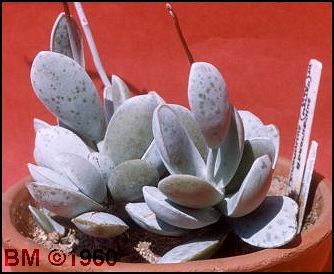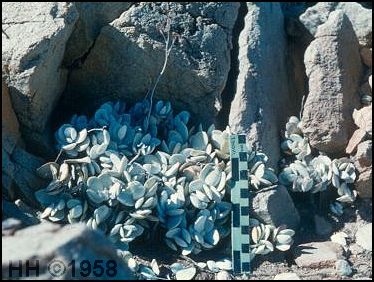From The
Cactulent: ADROMISCHUS LEUCOPHYLLUS
Official
Bulletin of the London Cactus Club - September 1958 vol. 10 no. 5 p.
56-58
by Bryan Makin (Editor) [Other articles by BM on
this web site: White
Adromischus, A.
hemisphaericus.]
"This
plant has always been a favourite of
mine, ever since I first saw it in
Blackpool in 1947. I was given a rooted
leaf at the time and have not been
without the species ever since. I had
never seen such pure white leaves on a
living plant before. It was this feature
which attracted me to it, so that I
carried that rooted leaf home as lovingly
as a new gold watch (not that I've ever
had a new gold watch to carry home!)The first shoot to come
through the soil was RED and I wondered
what had gone wrong. I now know that the
young leaves always start off red, then
turn green and, finally, white as the
mealy bloom develops over the epidermis.
This bloom covers the whole plant
including the stems and the flower stalks
and calyces. It is unfortunate that the
bloom is easily rubbed off and does not
renew itself, so that damage is
permanent. However, the species grows so
easily from leaf-cuttings that it is very
simple to replace a fingered specimen
with younger ones of unblemished,
pristine whiteness.
|
 |
Like the
leaves, the flower stalks start off red and then
whiten from the base upwards. [Visible in
illustration above-right.] They usually put in an
appearance about the beginning of May and grow to
about six inches or more before the first flowers
open in the late summer. These are pink - a sort
of pale, powder pink, which blends well with the
white bloom on the plant - and are approximately
1 cm in diameter. They remain open for quite some
time before finally fading, but don't seem to set
seed in this country unless I have failed to
notice it. This is quite unimportant anyway,
because of the ease of vegetative increase.
| With everything
apparently in its favour, it is a wonder
to me that A. leucophyllus is
still a pretty rare plant in collections,
but this certainly seems to be the case.
It was grown in this country, though not
widely by any means, for many years
before it was officially named. I always
knew it as "Adromischus
leucophyllus" but that was
found to be nomen nudum. Because this
name, meaning "with white
leaves", so aptly fits the plant, it
was made official in 1954 when Mr.
Uitewaal of Amsterdam, published the
requisite Latin diagnosis and a very
interesting description and history of
the plant. I was quite honoured that he
also published an Appendix and habitat
photograph that had been submitted by me.
[National C&S J. (1954) vol. 9 p.
58.] |

A. leucophyllus
photographed by Bryan in habitat in 1954. |
In 1954, I
was very pleased to be able to visit the little
"township" of Montagu, Cape Province,
which is the type locality for A.
leucophyllus. It doesn't extend very far
beyond the hills surrounding the town, so it is a
fairly limited species, even though it is
plentiful within these limits. I spent two days
examining thousands of wild plants and found
remarkably little variation. The flower colour
varied from pearly-white to medium-pink and the
limbs ("petals") varied from flat-open
to fully-reflexed but that was about all.
| In addition to the
typical plant, there is also a form in
which red spots show through the white
meal and this form produces a very pretty
plant. In every other respect, the two
forms are alike and so there is nothing
to justify a varietal name for the
spotted form and it is just called A.
l. forma maculata. I have
found that, growing under glass, the
spots tend to be rather less pronounced
than in the wild plants and less
obviously red, but the loss of
distinction is not too great. I am
hoping, eventually, to grow a selection
of propagated plants in an open cold
frame out-of-doors, where a previous
trial showed me that they should produce
growth and colouring far more typical of
wild plants. By growing them in a
cold-frame, instead of in the open garden
as last time, I will be able to have
better control of watering, should it be
a moist summer like this one, whilst
still allowing the direct sunlight to
fall on the plants. |

A. leucophyllus
with red spots as grown by Bryan. |
The white
colouring of A. leucophyllus is not an
indication that the plant should be grown in
limey soil. On the contrary, the natural soil is
derived from a form of sandstone, which usually
produces a slightly acid reaction. An open,
gritty soil containing humus suits this plant
admirably. Given careful watering especially in
the autumn, when the atmospheric humidity is
high, a warm sunny position in the greenhouse and
protection from very low temperatures in winter,
this plant will thrive and produce a permanent
stock through propagation. Frequent repotting is
quite unnecessary - but make quite sure that the
pot or pan used is wide enough to avoid undue
risk of blemishing the leaves.
| Adromischus
leucophyllus Uit. is an uncommon
plant, but very easy to grow once you've
got it. As with most of the other species
of this genus, it rests in winter which
is always a help to successful
cultivation. New leaves are produced in
spring and in autumn - whilst summer is
mainly given over to the development of
the flower stems which are produce
terminally. Never be induced to cut off
the flowers of Adromischus just because
they are not individually very large.
Look at them with a lens and you will see
just how lovely they really are. A.
leucophyllus is certainly no
exception to this and really looks
complete when it is carrying its open
flowers, as mine are at this
moment." |

Photographed in Oct.
1958 by Harry Hall again near Montagu. |
|